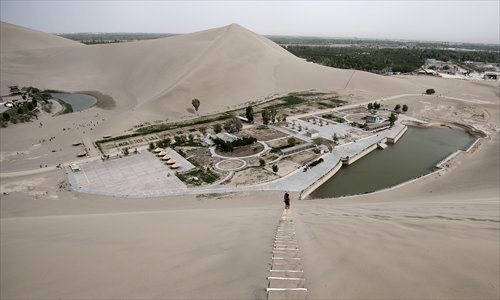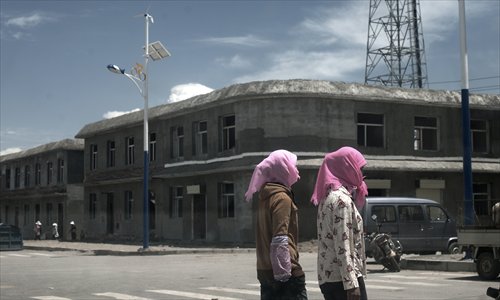HOME >> CHINA
Dunhuang runs dry
Source:Global Times Published: 2014-4-14 19:48:01

Clockwise from above: One of the two reservoirs (right) built to replenish the water level for the Crescent Spring lake (left). Photo: Li Qizheng/Sina
Dunhuang, an ancient town along the Silk Road where the famous Mogao Grottoes are located, is facing ecological deterioration.
Drought has been ravaging Dunhuang, which is nestled on a patch of grassland in the middle of the desert in Northwest China's Gansu Province.
The deterioration was a slow process, with the first warnings emerging as early as 40 years ago. Now, the accumulation of a variety of problems caused by the dry conditions severely threatens farming and is forcing residents to relocate.
Villages that were built decades ago to accommodate people relocated from dried-up regions and areas affected by the construction of reservoirs are also expected to soon be uninhabitable due to the intrusion of sand dunes. About 10 kilometers from Dunhuang's city center, one of these villages, Dunwan village, already looks empty. People are leaving for big cities to find work and new livelihoods, while students are trying their best to attend higher education institutes outside the region.
Experts blame the problem on the decreasing water volume of the two rivers flowing through Dunhuang. Local people have increasingly resorted to using groundwater in the face of the river water shortage, but the over-exploitation of groundwater is equally unsustainable.
The tourist attraction, Crescent Spring, a crescent moon-shaped small lake in the desert, has shrunk significantly over the decades, as a result of decreasing groundwater levels, from 22 mu (1.5 hectares) in the 1960s to only 8 mu at present. In order to keep it from completely disappearing, which could have occurred in less than a year, the local government built two reservoirs near it to bolster its water level.
In 2011, the State Council approved a plan to boost the water supply to Dunhuang, but because the project diverts water from another river and worsens the competition for water with upstream regions, it remains to be seen whether this solution will work.
Global Times

A woman dressed to protect herself in the sandy winds of Dunhuang. Photo: Li Qizheng/Sina

A man takes a bath in a stretch of the Shule River that hasn't yet dried up completely. Photo: Li Qizheng/Sina

Some villagers outside of Dunhuang have to fetch water from three kilometers away. Photo: Li Qizheng/Sina

Houses are left uninhabited in Dunhuang after people left to move to large cities. Photo: Li Qizheng/Sina
Posted in: In-Depth